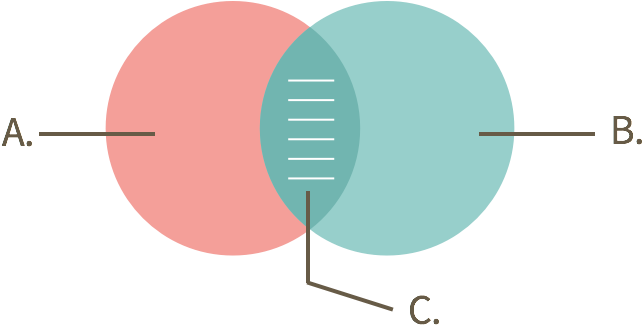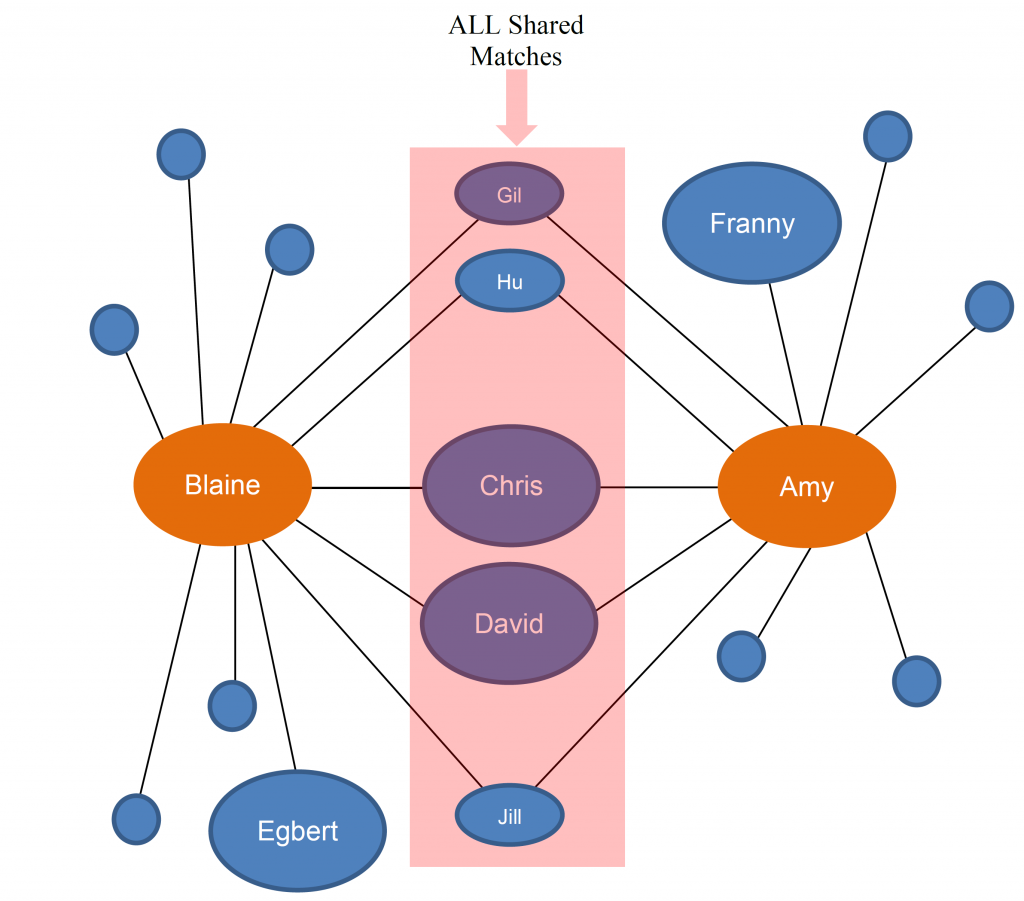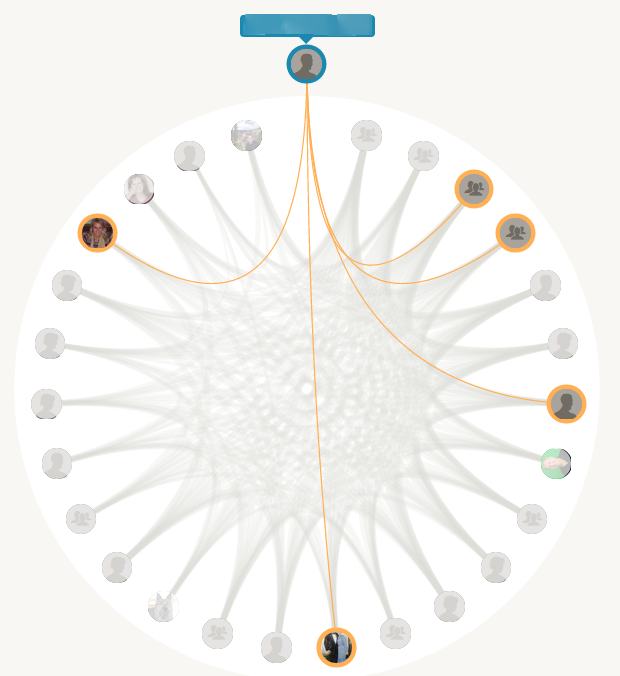With genetic genealogy the name of the game is collaboration, whether it is collaboration with other people or collaboration among the trees and records of our genealogical and genetic matches. Only when we collaborate can we generate the clues and information necessary to break through walls and recover the names of those missing ancestors.
We have multiple tools for collaboration of genetic matches. At GEDmatch and DNAGedcom, for example, we have many third-party tools that assist our efforts. The companies also offer tools that allow us to sift through our matches to find the clues we need. Family Tree DNA, for example, has an In Common With (“ICW”) tool and a Matrix tool that allow users to see what matches they share in common with another person.
Announcing Shared Matches
 On August 26th, AncestryDNA announced the “Shared Matches” tool, which is an ICW tool that shows you all the close matches you share in common with someone (usually, but not always, a genetic match) in the AncestryDNA database.
On August 26th, AncestryDNA announced the “Shared Matches” tool, which is an ICW tool that shows you all the close matches you share in common with someone (usually, but not always, a genetic match) in the AncestryDNA database.
You can check for a Shared Match with any of your genetic matches, all the way to the last person in your list of matches. You can even check for Shared Matches with people who have no tree or only a private tree! However, because of the limitation discussed below, you will expect to find fewer and fewer Shared Matches as you work your way down your list.
Before we launch into this, be sure to see “New AncestryDNA Common Matches Tool: Love It!” by Diahan Southard at Lisa Louise Cooke’s Genealogy Gems for some absolutely beautiful illustrations!
Fourth Cousins or Closer
There is a very important limitation of Shared Matches that has created most of the confusion about the new tool: the tool will only show fourth cousins or closer. In other words, for a Shared Match to show up, that Shared Match must be a fourth cousin or closer to BOTH you and the person you are checking for shared matches with.
Let’s use an example. My name is Blaine, and I have a great-aunt named Amy who has tested at AncestryDNA. I see Amy in my match list, so I click on the VIEW MATCH button to see Amy’s profile. There, I click on SHARED MATCHES to see the shared matches we have in common. I get a list that includes Chris. In order for Chris to appear in that list, he must satisfy two criteria:
- Chris MUST be a fourth cousin or closer to Blaine; AND
- Chris MUST be a fourth cousin or closer to Amy.
If Chris is a distant cousin to Amy, he won’t appear in our Shared Matches list EVEN IF he is a match shared in common with Amy and Blaine.
In the follow graphic, which works off the same example, Blaine and Amy both have an array of matches. Some of those matches are shared in common, as shown in the region highlighted in red. Of those, only Chris and David are fourth cousins or closer to BOTH Blaine and Amy, so only Chris and David will show up in the Shared Matches list. While Blaine and Amy share Gil, Hu, and Jill in common, they are all more distant matches and won’t show up in the Shared Matches list. Further, close matches like Franny and Egbert won’t show up because they aren’t shared by both Blaine and Amy.
As you can see from the above, do not use the absence of a match from an ICW group as evidence!
Shared Matches Groups
Amy, Blaine, and Chris create a “Shared Matches Group.” Note that this is NOT a triangulation group, and is not even a pseudo-triangulation group. But it is a group nonetheless, and should be explored for clues.
As one commenter pointed on in an ISOGG Facebook group thread, once you can show an ICW group to a match, they might be more likely to share information, upload to GEDmatch, or otherwise collaborate.
Using a real-life example, I have 120 genetic relatives at the fourth cousin or closer range. My great-uncle has 187 genetic relatives at the fourth cousin or closer range. My great-uncle and I have 10 Shared Matches (3 immediate family members I’ve personally tested, 2 second cousins, a third cousin, and 4 fourth cousins).
Why Fourth Cousins or Closer?
AncestryDNA explains that “Shared matches work best for closer relationships so you’ll only see “high confidence” matches (4th cousins and closer to each of you) in the list.”
There are certainly plusses and minuses to limiting Shared Matches to fourth cousins (“4C”) or closer.
On the one hand, for those without significant endogamy, limiting Shared Matches to the 4C or closer range results in greater confidence that the Shared Matches Group is based on a common shared ancestor. Of course it’s not a guarantee, but it is more likely than a scenario where you’re adding in much more distant relatives. The more distant the relationship, the more opportunity for a relationship through multiple lines, and/or through different lines.
On the other hand, several people have been underwhelmed by the new tool because they have found very few ICW matches, usually due to having very few genetic matches at the 4C or closer range. Hopefully everyone’s results will continue to improve as the database continues to grow.
Use Caution
Now remember, ICW status among three (or more) people IS NEVER confirmation or proof that ALL three people share common ancestors, much less that they share the same segment of DNA. (Although I’m a proponent of Genetic Networks so sharing the same segment of DNA (“triangulation”) is not always a requirement; however, ICW alone is never sufficient without more).
Using the example above, Chris may be related to Blaine and Amy through the same line or through unrelated lines. Unfortunately, this problem can be exacerbated by endogamy.
Using Shared Matches with DNA Circles and New Ancestor Discoveries (“NAD”)
During the discussion of Shared Matches on the ISOGG Facebook group, one commenter noted that you could check your shared matches not only with your genetic matches, but also with anyone in a DNA Circle or a New Ancestry Discoveries group.
In the NAD below, for example, the test-taker is only genetically related to people in the orange circle groups. However, the test-taker can check for Shared Matches ANYONE in any of the circles:
Clicking on one of the NAD members with whom you don’t share DNA will look like this:
Not surprisingly, most of the time you won’t share a match ICW these people. However, once in a while you will, and that might help you solve the mystery of the NAD.
Other Uses
Several people have indicated that they use the AncestryDNA Shared Matches tool together with the Snavely ICW feature to expand the ICW analysis.
Do you have any other uses or successes with Shared Matches? If so, feel free to leave a comment below.
Nope, It’s Not a Chromosome Browser…
This is not a chromosome browser and you won’t get segment data. But that doesn’t mean that the Shared Matches tool is useless or that it can’t provide valuable clues. Indeed, many people have already posted about how the tool has helped them.
So beware the naysayers, and wring this tool out for everything it’s worth!
Other Resources
- “See Your DNA Matches in a Whole New Way” on the Ancestry blog
- “Introducing AncestryDNA New ‘Shared Matches’ Feature” an Ancestry video at YouTube
- “AncestryDNA Shared Matches” by Angie Bush at DearMYRTLE
- “Finally!” at The Legal Genealogist
- “AncestryDNA FINALLY introduces new “In Common With” feature, SHARED MATCHES” at Roots & Recombinant DNA
- “New AncestryDNA Common Matches Tool: Love It!” by Diahan Southard at Lisa Louise Cooke’s Genealogy Gems
- “Ancestry Shared Matches Combined With New Ancestor Discoveries” at DNAexplained
- “AncestryDNA Adds Shared Matches Tool” at genealogyinsider



I know that the AncestryDNA blog and help file mention “4th cousins”, but I think that is a bit of a euphemism of sorts. The cut-off (other than for Circle members) is “Very High” and one can have more distant cousins who make that threshold (which is just 20cM.)
Puzzled – it’s definitely a semantics issue. I have people at AncestryDNA that are classified as Fourth Cousins with whom I share less than 20 cM, and they still show up in the ICW results.
So technically ICW at AncestryDNA works based solely on whether someone is a 4C or closer, but whether someone is actually a 4C or more distant is the real issue.
“On the one hand, for those without *significant* endogamy, limiting Shared Matches to the 4C or closer range results in greater confidence that the Shared Matches Group is based on a common shared ancestor.”
I’m not sure what counts as “significant” endogamy, but for me the 4C cutoff excludes too many matches known to be of high value (e.g., ICW matches that can be found in the DNA Circles) while including too many matches representing disparate lines. It’s not a helpful tradeoff.
An ICW tool such as those at FTDNA or GEDmatch would be more useful.
The section on population genetics offers some rationale for why they are limiting the results to 4th cousin or better. About 5 minutes in, there’s a diagram showing how multiple ancestors could be responsible for a match when you get to more distant levels. This may not be endogamy in the classical sense, but population of the US has expanded greatly from a relatively small pool of ancestors.
https://www.ancestry.com/academy/course/ancestry-dna-circles
Thank you for pointing that out, Ann. I haven’t had a chance to view the video yet, but it’s on my to-do list for today.
“…multiple ancestors could be responsible for a match when you get to more distant levels…”
I’m getting quite a bit of that even with the 4C cutoff. And yet ICW matches reported in the DNA Circles are excluded from the “Shared Matches” lists, closing off valuable avenues of investigation. A cutoff isn’t really necessary, but if Ancestry feels that it’s necessary to try to conceal the need for a chromosome browser by imposing an arbitrary cutoff, a 5C cutoff to match the DNA Circles would make more sense.
I think it’s a useful tool, and I’ve found a few clusters I can explore. I’m now going back to my 90 4th cousins saying “You show up in these three trees. Do you know how you match them/” Not one person has said yes so far (it’s only been two days), but it gives me a chance to tell them why they should be on GEDmatch – a TRULY useful tool.
Hopefully you’ll get some interest back from those individuals, Rich. I think ICW will be good for providing clues that we can follow, but only seldom will they be the smoking gun all by themselves. I’ve had some success creating Shared Matches Groups, but the next step – finding a common ancestor – will prove challenging.
There’s the same problem at FTDNA where ICW and segment data has been available; finding the common ancestor of a pseudo-triangulation group (where ICW status and segment data are used) is really, really tough.
I like your graphic representation of how it works. Makes more sense. At first I thought it wasn’t working for me. Then I had to look at the page numbers. They were reduced by a few pages. It’s like looking at my matches all over again in that particular order. I haven’t looked at the more distant ones to see but as you said, this does not confirm that all 3 parties share the same common ancestor. 🙂 Thanks for the explanation. I was reluctant to really read about it, until I saw your graph, then I got more interested.
That’s great Kalani, I’m glad the graphic was helpful!
I’ve used the dnagedcom Ancestry utility to download my shared matched. This will show shared matches for more distant cousins. I was able to use one of these more distant cousins to narrow down my possible relations with two 3rd cousins.
The dnagedcom utility reports the shared cm too. Not sure what Ancestry uses for the cm thresholds to determine “cousinage”. Two of my “3rd cousins” share 120 and 85 cm. I would think this is near 2nd cousin once removed or something else based on the ISOGG statistics. One (120 cm) is the great grandson of a couple. The other (85 cm) is a grandaughter of the same couple. [Yes, great grandson has more matching than the granddaughter]. Anyone have any thoughts on my possible relationship to them?
Thank you for a very informative and helpful article. I wanted to let you know that this post is included in my NoteWorthy Reads #22: http://jahcmft.blogspot.com/2015/10/noteworthy-reads-22.html Enjoy your weekend!
Thanks for this. I’ve been looking everywhere for practical tips on making the most of Ancestry’s current tool. The user community could use more articles like these. I’ll be bookmarking this site!
This site is awesome–thank you. Do you know of any way to determine how closely your Ancestry ICW matches match each other? It would be helpful to know if my two estimated 3rd cousins who match are siblings vs. distant relatives of each other.